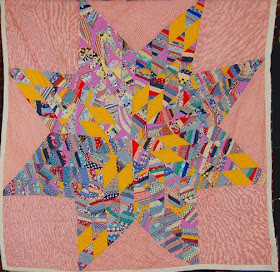Raleigh print in Shirting Cream
My new 19th-century reproduction Richmond Reds collection for Moda
is due for delivery mid-September, 2014
which means the precuts like Jelly Rolls and Layer Cakes should
be available soon.
There's a full-page ad for it on the first page of this months
Quilt Mania.
Several of the prints are available in a "Shirting Cream" colorway, such as
Raleigh (8304-11)
Here's the original document print for Raleigh--- a shirting with berries and sprig figure in a dark brown or black. Over the many decades the background has yellowed as cotton does with age.
We kept the aged look in some of the colorways, adding a touch of pinkish tan because the line is called Richmond Reds.
A shirting is a term for a light colored fabric with a simple, small figure.
This colorway is an echo of the very serviceable 19th-century
shirtings that were so popular for children's clothing
as in this lot from Augusta Auctions that look to be from the time of the Civil War
or earlier.
The fashion continued into the 20th century, Many of the kids in this one-room school from 1909 are wearing light prints.
Shirtings were also a necessity for scrap quilts.
All these auction quilts look to be about 1870-1920,
shirting's heyday.
And not so scrappy quilts until 1930 or so.
See another post about vintage shirtings:





























.jpg)





















































